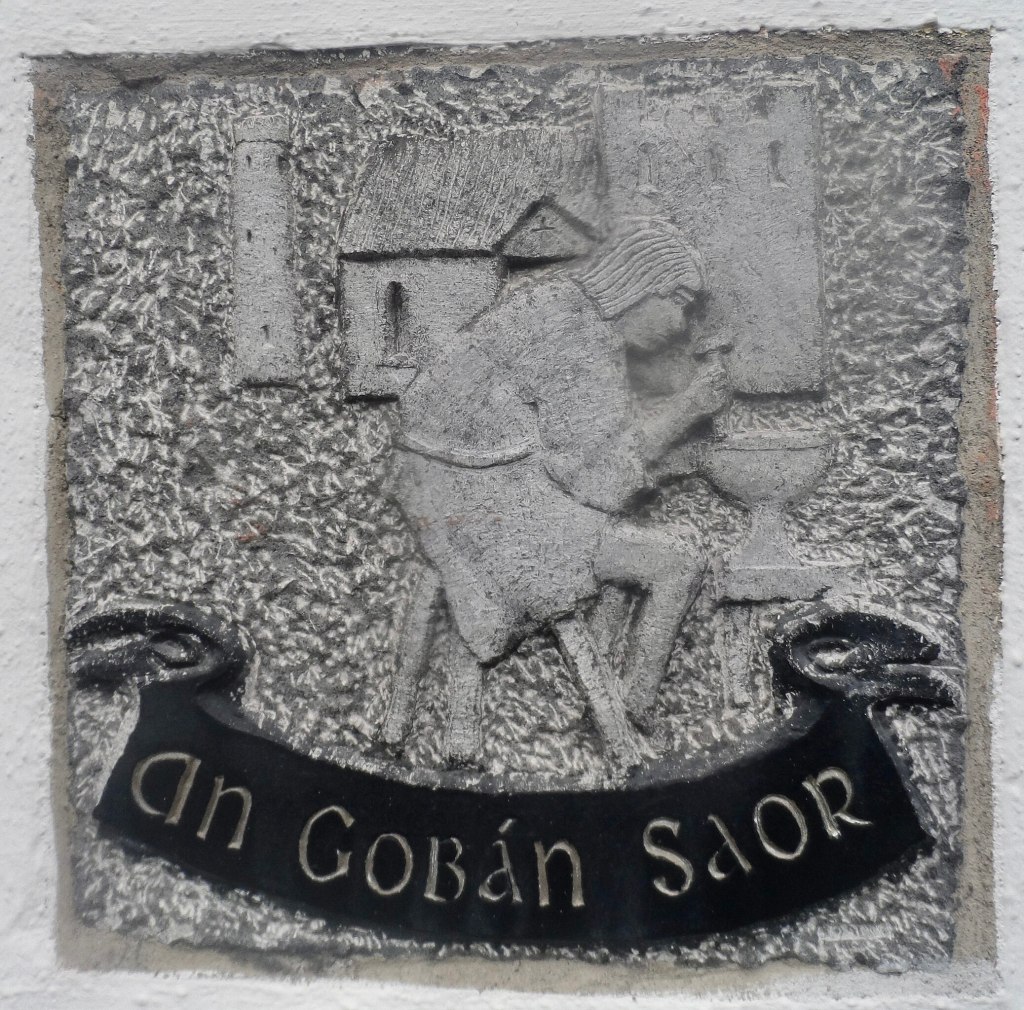(Image by Sheila 1988, Wikipedia Commons)
Irish stonemasons used a secret language known as bearlager na saor (also as Bearla lagair)., said to have come down from the great ancestor of masons, Goban Saor (variously spelt and pronounced gabawn seer). The mythic Goban Saor – Goban the builder – was, and is, the subject of a body of folktale traditions that present him as a clever and greatly skilled artisan who always outwits those who try to harm him or to refuse his rightful fee for work done. It was he who handed down the closely guarded skills of the stonemason, together with their confidential speech.
Towards the end of the nineteenth century, American word sleuths became aware of a curious language spoken by itinerant Irish workers, particularly stone masons. It was neither Old Irish, Gaelic or even Shelta, but seemed to have some similarities to all of these, as well as its own characteristics. One companion of itinerants, named A T Sinclair, inquired further into this among older Irish stone masons in Massachusetts and discovered that ‘On mentioning the subject to some old Irish masons here in Allston, I was surprised to find they could speak this language which they called “Bearla lagair na saor … a large number of other old Irishmen knew there was such a mason’s talk called ” Bearla lagair” ‘[1]
Sinclair’s informants told him this was a language known only to stonemasons and that no apprentice could claim his ‘indenture’, or trade qualification, without being able to speak it. Masons were forbidden to mention this speech to anyone who was not one of their guild, including their own families. The trade secrets also included special signs, skills and ways of using their tools, together with a variety of rules that must be followed and through which a mason could identify himself to another adept of the craft. Sinclair also collected stories about the Goban Saor, including this one which gives the origin of a famous stone mason’s mark:
Sometimes a love of adventure led the Goban Saor to wander incognito as a common workman. His renown as an architect and artistic sculptor was widespread. One simple story which amuses these workingmen is this. The Goban Saor once, in a foreign land, applied to the master- builder of a cathedral for work. ” What can you do? ” asked the master. “Try me and see,” was the laconic reply. Then the builder placed him in a work-shed alone by himself, and, pointing to a block of stone, said facetiously, “Carve from that a cat with two tails.” The shed was fastened at night, and the next morning Goban had disappeared. When the master unfastened the shed and looked in, he found that the block of stone had been most beautifully carved into a cat with two tails. With an exclamation of surprise, he ejaculated, “It was the Goban Saor himself! No other human being could do such superb work, or so quickly.”[2]
Sinclair gave a selection of Bearla lagair words, mostly those similar to the travellers’ language of Shelta, including:
Un twede dut na bini – do you speak Mason’s talk?
Minkur – low people
Shin – sing
Eolor – mortar
Glom -yell
Miar – devil, bad luck
Shihukh – whisky, with Sinclair’s comment ‘a large number of other words also’
Skrugal – throat
(NB – diacriticals removed here and throughout)
Bearla lagair was still being spoken by older Irish stonemasons resident in London during the 1970s and was reported to have been widely spoken among Cork stonemasons.[3]
In short, no one really knows exactly where this cryptolect comes from. But we do know that it existed as a secret language among Irish stonemasons and, perhaps, still does. The Stonemason’s Guild of St Stephen and St George maintains a ‘cosmopolitan’ version of Bearla lagaire developed around London and said to be a more sophisticated speech than the ‘argot used by rural rough masons’. The Guild says that the language, which they call ‘bine’, was regularly used in the UK and Ireland until the 1980s and that there are still stonemasons ‘who still hold and use the language today.’ [4]
[1] Sinclair, A. T. ‘The Secret Language of Masons and Tinkers’, The Journal of American Folklore, vol. 22, no. 86, 1909, pp. 353–64. P. 354. JSTOR, https://doi.org/10.2307/534860. Accessed 8 Apr. 2024
[2] Sinclair, p. 356.
[3] Mudcat Café thread, ‘Goban Saor’, May and August 2002. See also Brian Cleeve, ‘The Secret Language’, Studies: An Irish Quarterly Review, Vol. 72, No. 287 (Autumn, 1983), pp. 252-262, 363.
[4] https://www.guildsg.org/bearlish, accessed September 2019.
